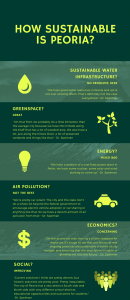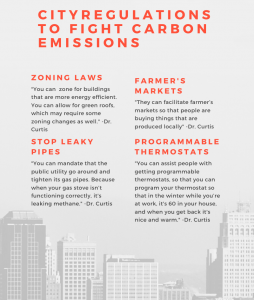The climate is changing. The planet is warming. Human action is causing it.
At this point, denying climate change is almost like denying gravity or saying that the Earth is flat.
If we want to keep the Earth below the 2℃ temperature increase that scientists are warning will be catastrophic, there will need to be action on all levels of government, even individual cities.
The United Nations Development Programme emphasized the importance of local governments in the fight against climate change. The knowledge that they possess about local needs and the local environment will allow resources to be used in the most efficient way.
One way that local and state governments can make an impact is by ensuring that the infrastructure they build is sustainable.
Dr. David Spelman, an assistant professor in the Civil Engineering and Construction department at Bradley University, said there are many factors that go into determining whether an infrastructure project is sustainable.
“You have to look at, separately, the economic, social, and environmental parts,” explained Dr. Spelman. “The hiring practices for the workers have been equitable in a way, proper environmental impact assessments have been done to make sure that it is being done in a good way, and of course infrastructure is expensive, so society’s resources are being best utilized in the way that we’re going about this.”
Dr. Spelman said that Peoria’s infrastructure is about average for Midwestern cities in terms of sustainability. If he had to give it an overall grade, Peoria would get a ‘D’. Dr. Spelman stressed, however, that he wasn’t picking on Peoria when he gave this grade.
“[The grade] is a combination of historical practices, which has led to where we are now, and it’s also how sustainable our active measures to improve for the future are,” said Dr. Spelman. “On those active measures, definitely a lot better than a D. I think we’re doing reasonably well. But if you account for just where we are given the history, it’s tough.”
In addition to building sustainably, there are regulatory steps local governments can take to limit the area’s carbon emissions.
Dr. Craig Curtis, a professor in the Political Science and International Studies department at Bradley University, said that, in general, cities have control over zoning laws that can limit negative environmental impacts, like halting the development of sprawling suburbs.
“If you facilitate development in the suburbs, you’re increasing your carbon footprint,” said Dr. Curtis. “People who live in the suburbs and commute in have a much bigger carbon footprint for a variety of reasons. They tend to have bigger houses. They tend to use more energy in heating and cooling their houses. They tend to use more energy driving. They tend to have bigger cars.”
Dr. Curtis explained that redeveloping former industrial areas and investing in public transportation can reduce cities’ carbon footprints by encouraging people not to move out into the suburbs.
Ryan Hidden, an Organizing Representative with the Sierra Club, said that Peoria has a plan to become more sustainable, and that they could make progress towards that goal by making city owned property more energy efficient.
“The city owns a lot of buildings and a lot of land, and there’s more things they could do in the nature of putting solar panels on their buildings,” said Hidden. “They have done some switching out lightbulbs for more energy efficient LEDs, there’s more of that they could do, and just making their buildings more energy efficient. Trying to get to net zero, so their buildings are producing the energy they need and not getting energy from the grid.”
Climate change is an issue that will affect almost every aspect of life across the planet. Tackling it will take international, national, state and local government action around the world.


